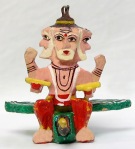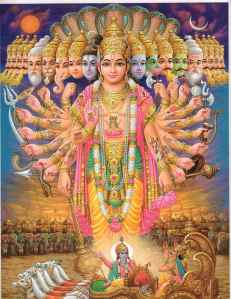 Vishnu
Vishnu
Vishnu (IAST viṣṇu, Devanagari विष्णु), (honorific: Bhagavan Vishnu), is the Supreme God in Vaishnavite tradition of Hinduism. Smarta followers of Adi Shankara, among others, venerate Vishnu as one of the five primary forms of God, and his supreme status is declared in the Hindu sacred texts like Yajurveda, the Rigveda and the Bhagavad Gita.
The Vishnu Sahasranama declares Vishnu as Paramatma (supreme soul) and Parameshwara (supreme God). It describes Vishnu as the All-Pervading essence of all beings, the master of—and beyond—the past, present and future, the creator and destroyer of all existences, one who supports, sustains and governs the Universe and originates and develops all elements within.
In the Puranas, Vishnu is described as having the divine color of clouds (dark-blue), four-armed, holding a lotus, mace, conch and chakra (wheel). Vishnu is also described in the Bhagavad Gita as having a ‘Universal Form’ (Vishvarupa) which is beyond the ordinary limits of human sense perception.
The Puranas also describe each of the Dasavatara of Vishnu. Among these ten principal avatars described, nine of them have occurred in the past and one will take place in the future, at the end of Kali Yuga. In the commentary of creator Brahma in Vishnu Sahasranamam, he refers to Vishnu as “Sahasrakoti Yuga Dharine”, which means that these incarnations take place in all Yugas in cosmic scales. The Bhagavad Gita mentions their purpose as being to rejuvenate Dharma and vanquish negative forces as also to display His divine pastimes in front of the conditioned/fallen souls. In almost all Hindu denominations, Vishnu is either worshiped directly or in the form of his ten avatars, such as Rama and Krishna.
The Trimurti (English: ‘three forms’; Sanskrit: trimūrti) is a concept in Hinduism “in which the cosmic functions of creation, maintenance, and destruction are personified by the forms of Brahma the creator, Vishnu the maintainer or preserver, and Shiva the destroyer or transformer. These three deities have been called “the Hindu triad” or the “Great Trinity“. Of the three members of the Trimurti, the Bhagavata Purana explains that the greatest benefit can be had from Vishnu.
The Ten Avatars of Vishnu
There are ten avatars of Vishnu (dashavatara) commonly considered as the most prominent.
1. Matsya :- 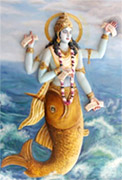
Matsya (Sanskrit: मत्स्य) (Fish in Sanskrit) was the first Avatar of Vishnu in Hindu mythology.
According to the Matsya Purana, the king of pre-ancient Dravida and a devotee of Lord Vishnu, Satyavrata who later becomes known as Manu was washing his hands in a river when a little fish swam into his hands and pleaded with him to save its life. He put it in a jar, which it soon outgrew. He then moved it to a tank, a river and then finally the ocean but to no avail. The fish then revealed himself to be Lord Vishnu and told him that a deluge would occur within seven days that would destroy all life. Therefore, Satyavrata was instructed to take “all medicinal herbs, all the varieties of seeds, and accompanied by the seven saints” along with the serpent Vasuki and other animals.
The deluge occurred and the lord reappeared as promised and advised Sathyavrata to board the boat and fasten the serpent Vasuki to his horn as a rope to the boat.
Matsya is generally represented as a four-armed figure with the upper torso of a man and the lower of a fish.
2. Kurma :-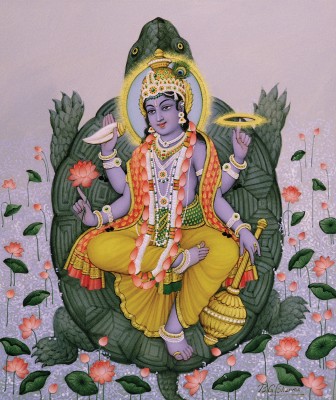
In Hinduism, Kurma (Sanskrit: कुर्म) was the second avatar of Vishnu. Like the Matsya Avatara also belongs to the Satya yuga.
The Devas lost their strength and prowess due to a curse by the sage Durvasa because Indra, the king of the Devas, had insulted the sage’s gift (a garland) by giving it to his elephant which trampled upon it. Thus, after losing their immortality and kingdom, they approached Lord Vishnu for help.
Vishnu suggested that they needed to drink the nectar of immortality to regain their lost glory. However, they needed to strive hard to acquire the nectar since it was hidden in the ocean of milk. After declaring a truce with their foes (Asuras), Indra and his Devas together with the Asuras, use the serpent Vasuki as a churning rope and the mount Mandara as the churning staff.
When they began churning, the mount began sinking into the ocean. Taking the form of a tortoise (Kurma), Vishnu bears the entire weight of the mountain and the churning continues and various objects are thrown out including the deadly poison Halahala, whose fumes threaten to destroy the Devas and the Asuras. Lord Shiva then comes to their rescue and gathers the entire poison in his palm and drinks it. His consort, Parvathi, clasps his throat and the poison remains there. Hence he became known as “Neelakanta” (literally: “the blue-throated one).
“Fourteen precious things” come out of the ocean, culminating with Dhanvantari, the physician of the gods, appearing with the nectar of immortality. The Asuras immediately rush and grab the nectar while quarreling among themselves.
Vishnu again comes to the rescue in the form of a beautiful damsel, Mohini and tricks the Asuras and retrieves the potion which is distributed to the Devas. Though the Asuras realize Vishnu’s tricks, it is too late, as the Devas regain their renowned prowess and defeat them.
3. Varaha:-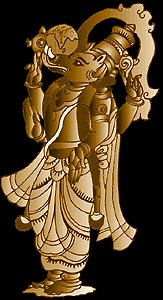
Varaha is depicted in art as either purely animal or as being anthropomorphic, having a boar’s head on a man’s body. In the latter form he has four arms, two of which hold the wheel and conch-shell while the other two hold a mace, sword or lotus or make a gesture (or “mudra“) of blessing. The Earth is held between the boar’s tusks.
The avatar symbolizes the resurrection of the Earth from a pralaya (deluge) and the establishment of a new kalpa (cosmic cycle).
The Varaha Purana is a Purana in which the form of narration is a recitation by Varaha.
Temples dedicated to Varaha
- Sri Varaham – in Trivandrum, near South Fort.
- Srimushnam – This temple in Tamil Nadu named is considered a Swayambhu Murthi, as are Tirupati and Badrinath.
- Varah shyam temple – This temple is located in BHINMAL city in Jalore District. Here is present a large idol of God VARAHA. It is an ancient temple and is situated in the middle of the city.
- Varaha temple – This temple is in Varaha Village in Jind District, Haryana. Here is a Swayambhu Murthi of God VARAHA.
- Thiruvidandai- In this temple near Chennai Varaha is also called Nityakalyana Perumal. It is famous for marriages and is one of the Divya desam.
- Simhachalam – The famous Varaha LakshmiNarasimha swamy temple, one of the most prominent in Andhra Pradesh.
- Tirupati – Sri VarahaMurthy Temple at Tirumala – Tirupati|Tirupati is considered to be a very ancient temple. Pilgrims should first worship Lord Varaha and then Lord Venkateswara. It is also known as Aadhi Varaha Kshetra.
- ThirukKalvanoor – Aadi Varaha Perumal in Kamakshi Amman Temple, Kanchipuram.
- [Thiruvalavendhai / Valavendhai Piraan / Gnaanapiraan] – Thirukkadalmallai (Mammallapuram) – Aadi Varaha Perumal holding Akhilavalli Thaayaar (Bhudevi) on His right. The only Varaha temple where Perumal holds Thaayaar on His right.
- Sukarkshetra Temple – This temple is situated on the bank of Sarayu river in Paska village of Paraspur circle in Gonda district of eastern Uttar Pradesh (India).
- YagnaVaraha- This temple is located in Karimnagar District, AndhraPradesh. The rituals are done according to Vaikhanasa Agama.
Narasimha, the Man-Lion (Nara = man, simha = lion).
- Vamana, the Dwarf Brahmin (priest).
- Parashurama, Rama with the axe, who appeared in the Treta Yuga.
- Rama, Sri Ramachandra, the prince and king of Ayodhya.
- Krishna (meaning ‘dark coloured’ or ‘all attractive’ or the Existence of Bliss, [30]), appeared in the Dwapara Yuga along with his brother Balarama. Balarama is included as the eighth Dasavatara which list Krishna as the source of all avatars, svayam bhagavan (this viewpoint is specific to Bhagavata, Gaudiya, Vallabhacarya and Nimbarka sampradayas) .[31]
- Buddha, the thinker. (See Gautama Buddha in Hinduism)
- Kalki (“Eternity”, or “time”, or “The Destroyer of foulness”), who is expected to appear at the end of Kali Yuga, the time period in which we currently exist.
